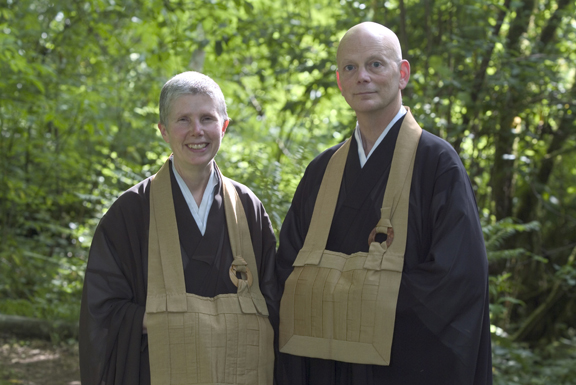When Eating, Just Eat
Jan Chozen Bays ’66 has a mindful prescription for reordering our disordered relationship with food.
IT IS NOT JUST WHETHER YOU ARE HUNGRY, BUT HOW. There are seven kinds of hunger, writes Jan Chozen Bays ’66, a pediatrician and Zen teacher, in her recent book, Mindful Eating: A Guide to Rediscovering a Healthy and Joyful Relationship with Food. There is eye hunger, and there is nose hunger, motivated by the visual appeal and aromas of food, respectively; and there is mouth hunger, driven by the tongue’s desire for new sensations or textures. “I call the mouth a cavern of desire,” says Bays. It is never satiated. “Has your tongue ever told you, ‘Stop, stop, I don’t want to eat more?’”
There is hunger of the mind, fueled by thoughts about what you should be eating—or should not be eating—and hunger of the heart, fueled by a feeling of loneliness, of emptiness. There is stomach hunger, which everyone recognizes, but there is also a deeper and more profound bodily hunger than that—cellular hunger, a call for specific nutrients that the body needs, which manifests in a desire for red meat, say, if you’re anemic, or orange juice if you have a cold.
“If we are to return to a healthy and balanced relationship with food, it is essential that we learn to turn our awareness inward and to hear again what our body is always telling us about its needs and its satisfaction,” Bays writes. “To learn to listen to cellular hunger is the primary skill of mindful eating.”
Mindfulness, as Bays defines it, “is the act of paying full, nonjudgmental attention to our moment-to-moment experience…. Through mindful eating we can learn to be present when we eat. It seems so simple, to be aware of what we are eating, but somehow we have lost track of how to do it. Mindful eating is a way to reawaken our pleasure in simply eating, simply drinking.”
At the Great Vow Zen Monastery in Clatskanie, Ore., where Bays lives and teaches, at least one meal a day is eaten in accordance with the Zen ritual of oryoki, which translates roughly as “just enough.” The meal is eaten in silence, save for chanting, out of a special set of black bowls of varying sizes that stack together. The biggest bowl is generally reserved for grain such as rice or quinoa; the second contains a bean, egg, or tofu dish; the third holds salad or vegetables; and the fourth is filled with tea. For utensils, there is a lacquer spoon, a pair of chopsticks, and a spatula with a cloth tip that the diners use to clean their individual bowls when they are done. “[Oryoki] includes not just mindful eating but careful attention to all aspects of the meal,” Bays writes. “There is a precise way to lay out the nested eating bowls, to serve and receive food, to hold the bowls and utensils while eating, to clean the bowls, to dry and wrap them up again.”
Bays began practicing Zen meditation in 1973, during a year in Australia between her pediatric internship and residency. Immediately, she loved it: “I think the reason I loved it is that it reminded me of my childhood. We lived in a rural area when I was growing up, and I would spend Saturdays outdoors in the forest by myself, very meditative, trying to be so quiet that the animals wouldn’t detect me.”
She grew up mostly in upstate New York, where her father was a professor of library science at the State University of New York–Albany. (“We had a house full of overdue library books,” she says.) But she had spent her early childhood years in Alabama, where her father taught at the historically black Talladega College, and two of her teenage years in Korea.
Bays majored in biology at Swarthmore and attended medical school at the University of California–San Diego. With her first husband, she had two sons before and during medical school respectively and later adopted a daughter from Vietnam. After working as a general pediatrician, she switched to an exclusive focus on child abuse and, in 1987, helped found the CARES (Child Abuse Response and Evaluation Services) Northwest Center, where doctors work in coordination with professionals from law enforcement and child protective services. The center sees about 120 patients per month for suspected abuse or neglect. “To be in the midst of so much human suffering every day is very tough,” Bays says. “I couldn’t have done it if I hadn’t had my meditation practice to help clear my mind of all of the horrible things I heard during the day.”
Bays remains on the staff of the Children’s Hospital at Legacy Emanuel in Portland, Ore., and regularly provides training on recognizing child abuse. But she has largely scaled back her medical practice, and today, she says, “Pretty much my life is a Zen life.”
She and her second husband, Laren Hogen Bays, are the co-abbots and were among the founders of the Great Vow Zen Monastery, which they converted from an elementary school in 2002: It sits on 21 acres of land, encompassing forest and meadow, an organic garden, and two 20-by-80–foot greenhouses. The school library is the meditation hall; the classrooms are dorm rooms. The music room is now the practice space for the monastery’s marimba band.
The monastery, which has a resident community ranging from 12 to 25 and hosts up to 60 people during retreats, is one of just a handful following the Japanese Zen tradition in the United States. “One of the reasons we founded it was that Zen Buddhism was becoming quite popular in the United States, but there’s a tendency for it to get diluted,” says Bays. “It’s widely accessible, but there’s also a need to anchor the deep end of spiritual practice.”

Oryoki Recitation: “The first portion is for the Three Treasures. The second is for our teachers and parents. The third is for all nations and all beings. Thus we eat this food with everyone. We eat to stop all harming, to practice serving, and to accomplish the Awakened Way.”
A typical day at Great Vow begins with the wake-up bell at 3:50 a.m. and includes meditation in both morning and evening with two work periods and temple cleaning in between—plus five rounds of chanting a day. Six days of each month are spent in silence. As for oryoki, the ancient formal eating ceremony, Bays writes that it “has significance both in the mundane world and the world of mystery that interpenetrates it. In the mundane world, it is eminently practical—a way to feed the hundreds or even thousands of monks who gathered in the monasteries of China and Japan with a minimum of dishes to wash.”
“We wouldn’t think of eating out of bowls, day after day, that have never been washed,” Bays writes. “And yet we try to function with a mind that is never washed clean of thoughts. They pile up endlessly upon each other like decaying bits of food, stirred around by each newly added thought…. In the world of mystery, oryoki reminds us that emptiness is fundamental.”
Mindful Eating represents a fusion of Bays’ backgrounds in meditation and medicine. Although she was inspired by the enthusiasm for mindful eating retreats hosted by the monastery, her book is written with a much more general audience in mind. As she writes in the first chapter: “This book is written for all those who would like to improve their relationship to food. Whether you have a moderate tendency to overeat, as many of us do, or whether you are struggling with obesity, bulimia, anorexia, or other such problems, this book is for you.” The book is accompanied by an audio CD with guided exercises on mindful eating and includes many practical tips.
Above all, Bays wants to take on what she describes as a “serious epidemic of disordered relationships to food and eating” at what she sees as its source—the mind and the heart. “The mind has two modes—thinking and awareness. When you eat, you want to turn off the thinking mode and turn on the awareness mode and just be fully present with the food, without anxiety.”
“If you’re really present while eating you’ll enjoy it more, you’ll have a richer experience, and you’ll probably eat less, if that’s your goal. You’ll feel more satisfied. There’s an old Zen saying, ‘When eating, just eat.’”
Elizabeth Redden ’05 is a freelance writer and instructor of undergraduate writing at Columbia University.
 Email This Page
Email This Page
